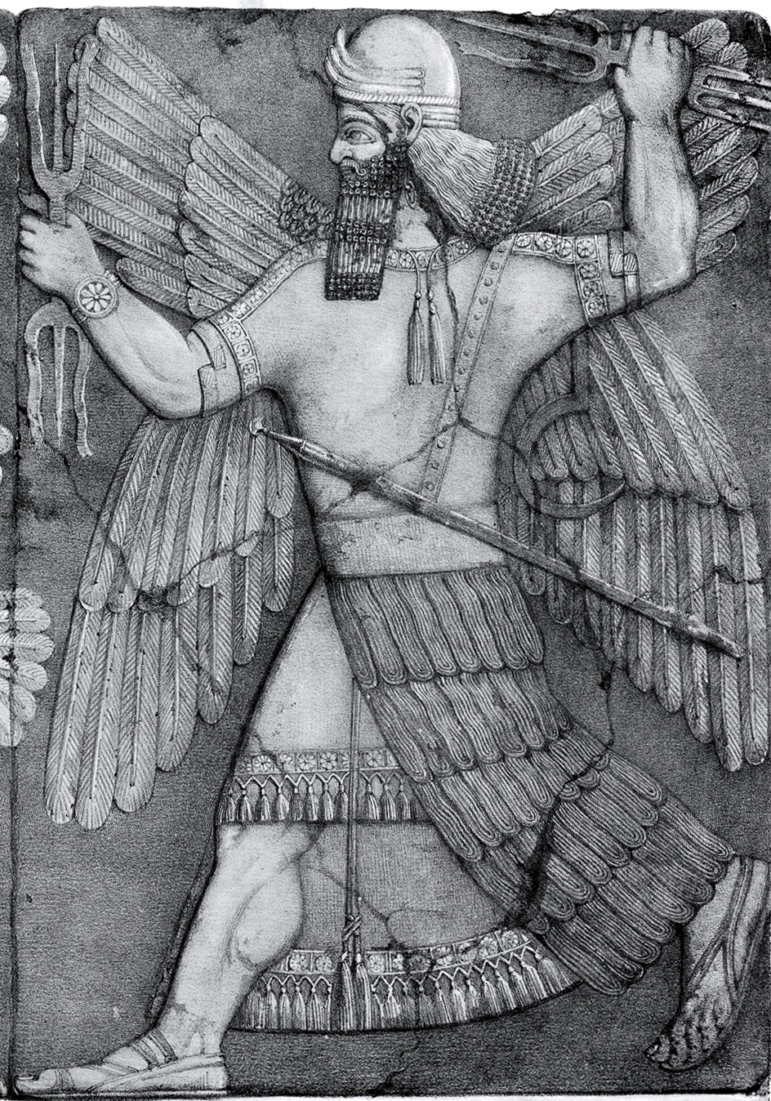TWH – Archaeology Magazine recently published an article on excavations from 2016 to 2019 in Iraq. Those excavations have found the remains of a legendary Sumerian temple, that of The White Eagle. The recent excavations have shed light on the politico-religious practices of ancient Sumer.
These findings build on earlier excavations. From 1877 to 1933, French archaeologists had excavated the remains of the Sumerian city of Girsu. From roughly 3000 to 2001 B.C.E, Girsu was a major sacred site in Mesopotamia. The Sumerian god, Ninĝirsu (also known as Ninurta) acted as the city’s patron.
Sumer depended on irrigation from the Tigress and Euphrates Rivers to produce its agricultural wealth. In the mythology of Sumer, the god, Ninĝirsu, defeated the demons who lived near the headwaters of those two rivers. The battle between Ninĝirsu and the demons tamed the rivers and made irrigation possible. Ninĝirsu became associated with floods, agriculture, and irrigation. As the god who battled demons, Ninĝirsu maintained cosmic order. The White Eagle was his “avatar.” Later, as Mesopotamia became more violent, Ninĝirsu became more of a god of war.

Stone relief carving of Ninurta/Ninĝirsu – Image credit: Katolophyromai – CC0 – WikiCommons
The dream of Gudea
During their excavations, the French uncovered a pair of clay cylinders. On those cylinders had been inscribed with a poem of the dream of Gudea, a ruler of Girsu from about 2150 to 2125 B.C.E. At 1,400 lines. The poem is the longest Sumerian poem known.
Gudea had dreamt that a human giant, flanked by lions stood, before him. The giant had the head of a god and the wings of an eagle. His lower body appeared as a flood wave. He said to Gudea, “Build me a house.” Nearby, a woman examined a tablet with stars showing. Birds in the trees chirped incessantly. A stallion pawed the ground. The dream disturbed him greatly.
Gudea then traveled by canal to The temple of Nanshe, the goddess of prophecy, to learn the meaning of this dream. She explained to Gudea that Ninĝirsu had taken the form of the giant. He wanted Gudea to build him a new temple. The woman looking at the tablet with stars indicated astrological auspiciousness. The incessantly chirping birds meant that Gudea could obtain no rest until he had completed the temple. The stallion pawing the ground showed the eagerness of Gudea to build the temple.
The temple
In the culture of Sumer, the statues of the gods would have been believed to radiate power and were vessels for the gods to inhabit. The temple itself would have been considered to be alive with the energy of the god. The physicality of the temple’s function was to contain that radiance. The outer walls of the Temple of the White Eagle had a thickness, 13 feet thick (3.96 m), exceeding that needed for structural support.
Sebastien Rey, Ph.D., has led the archaeological team at Girsu since 2015. He estimated that the entire temple complex covers 40,000 sq. ft. (0.37 ha).
The god’s vessel or statue would have resided in the inner sanctum of the temple. In the inner sanctum, the archaeologists found a podium. Priests would place the god’s statue on that podium. An offering table stood before the podium. It had traces of burnt material, possibly incense or some other burnt offering. Every day, priests would awaken the god’s statue, clothe and feed him. Every night, the priests would put the god’s statue to bed.
Two towers stood on either side of the entryway to the inner sanctum. Under one of these towers, archaeologists found a tablet. That tablet stated that Gudea had built this temple for Ninĝirsu. This confirmed that they had found the Temple of the White Eagle. They found identical dedications on clay cones in the temple and vessels imported from Iran.
Twice a year, the god’s statue, Ninĝirsu, would leave the temple, riding out in a chariot. The chariot with its divine radiance would go out into the country. Then it would return to the temple, where a great feast would occur. That feast would last for three or four days.
On one stature, Gudea is holding plans for a building on his lap. Those plans exactly match the layout of the temple. Archaeologists used that statue’s building plans to identify a possible location for a gate. They excavated at that spot and found that gate.

Votive stele of Gudea – Image credit: Osama Shukir Muhammed Amin FRCP(Glasg) – [CC BY-SA 4.0]
Secular reasons why Gudea moved the temple site
The city-state of Girsu had rebuilt the temple many times. Following tradition, the Sumerians built the new temple atop the old one. The French had found four or five successive temples, but not the temple that Gudea had built. Those temples dated from about 2700 to 2200 B.C.E.

Statue of Gudea, British Museum, Middle East – Image credit: By Vassil – [CC0 – WikiCommons]
The rebuilding of the temple of Ninĝirsu in a different location broke with Sumerian tradition. According to Rey, the new site had been the site of a temple to Ninĝirsu’s wife, Bau.
Gudea had married the daughter of Ur-Bau who had preceded Gudea as the ruler of Girsu. Gudea may have moved the temple to enhance his legitimacy or to assert patriarchal power over Bau’s temple.
The Wild Hunt is not responsible for links to external content.
To join a conversation on this post:
Visit our The Wild Hunt subreddit! Point your favorite browser to https://www.reddit.com/r/The_Wild_Hunt_News/, then click “JOIN”. Make sure to click the bell, too, to be notified of new articles posted to our subreddit.
